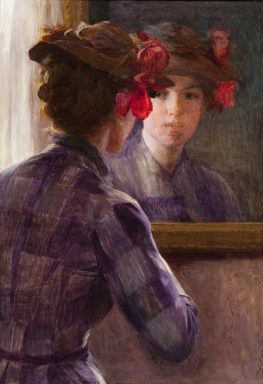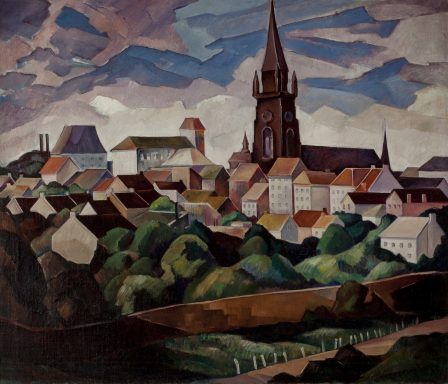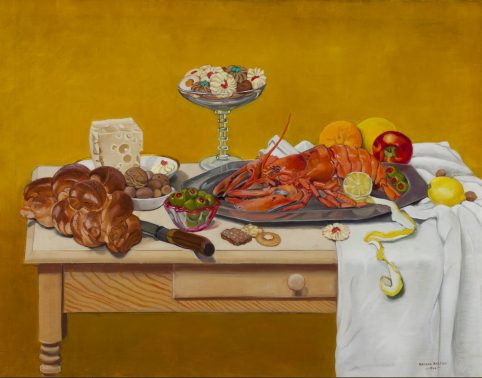Collected Artists
Represented in the M. Christine Schwartz Collection are numerous artists who worked in Chicago before World War II. Around the turn of the twentieth century Chicago emerged as a locus of artistic activity whose vitality paralleled that of the city’s commerce and industry. At its center was the Art Institute of Chicago, founded in 1879. Aspiring artists from throughout the Midwest flooded to the Art Institute’s school, where many also found employment as teachers, from L. C. Earle and Jessie Pixley Lacey to Ethel Spears and Laura van Pappelendam. Chicago offered further opportunities in many other art-related fields. Charles Corwin and Frank C. Peyraud were successful mural painters, for example, and Minerva Chapman found a ready market for her miniature portraits. James William Pattison, among others, made his mark in art journalism, while Otto Hake worked as an illustrator and Walter Krawiec as a newspaper cartoonist.
Chicago was already a nationally important venue for contemporary art exhibitions by the time the Art Institute initiated its highly influential annual juried exhibition of American paintings and sculpture in 1888. Less than a decade later the growing strength of the local artistic community prompted the inauguration of a yearly show devoted to Chicago-area creators, known beginning in 1913 as the “Chicago and Vicinity” show. The Art Institute also hosted solo and small group exhibitions for artists of Chicago as well as members’ shows of local art organizations. In the 1940s the museum even had a dedicated “Room of Chicago Art.”
Beyond the Art Institute, resident artists gained exposure in exhibitions staged by a growing number of artists’ associations—from the Palette and Chisel Club to the Arts Club of Chicago. Exhibition venues included commercial galleries, civic clubs’ meeting rooms, and department stores, in addition to artists’ studios. Chicagoans showed with state and regional organizations such as the Society of Western Artists and the All-Illinois Society of Fine Arts, in major annual salons in New York, Philadelphia, Pittsburgh, and other cities, and in the fairs and expositions that proliferated throughout the nation in the two decades following Chicago’s World’s Columbian Exposition of 1893. At home the growth of neighborhood and suburban artists’ groups and art fairs, as well as associations along the lines of ethnic identity and for women artists, created yet more opportunities for professional community, study, and audience development. And between the mid-1930s and the early 1940s many Chicago-based artists joined federal relief projects, finding not only financial support but access to a broad public through exhibitions, installations, and commissions in public buildings.

Many European-trained artists of Chicago painted portraits in parallel with more imaginative figural subjects.
Throughout its history Chicago has lost countless artists because of the greater opportunities and prestige offered elsewhere, notably Europe and New York and later the American Southwest and California. Numerous artists spent a significant part of their career in Chicago before moving on, such as Charles Edward Boutwood and Junius Sloan. Yet many remained in the city, even as they traveled widely to paint. Frederick W. Freer and Alfred Juergens were natives who remained identified with Chicago; others arrived in the city at a young age to train, as did Charles H. Kellner and Sam Ostrowsky, and some, like Albert Fleury, were fully fledged professionals when they settled in Chicago.
Following the example set by George P. A. Healy in the mid-nineteenth century, many local artists made portraiture a staple of their practice, even using it to underwrite their endeavors in landscape and other, more speculative fields. The potential for portrait commissions drew Ralph Clarkson and Arvid Nyholm, among others, to settle in the city. European-trained artists such as Oliver Dennett Grover and Pauline Dohn (Rudolph) painted portraits in parallel with imaginative figural subjects. These two were among many local artists whose works were displayed at the World’s Columbian Exposition, and they also created decorative murals for buildings at the fair.

Chicago-based landscape painters traveled nationally and internationally in search of subjects.
In the wake of the Exposition, numerous Chicago painters, notably Alice Kellogg Tyler, came under the sway of impressionism, with its emphasis on bright color, evident brushwork, and attention to the transient effects of light. Karl Buehr and Pauline Palmer were deeply influenced by their stays at the impressionist colony in Giverny, France; they, along with Lawton Parker and Louis Ritman, were among the many Americans in Giverny who focused on the female figure posed outdoors or in light-filled private interiors. At home, Adam Emory Albright realized a successful career painting country children in sunny rural settings. All these artists employed the impressionist technique of painting outdoor scenes en plein air, or in front of the subject (rather than indoors in the studio, from sketches—according to academic tradition). Escaping Chicago during the summer, artists in regional art colonies focused on painting the figure in natural light. At Saugatuck, Michigan, for example, Frederick Fursman taught Edgar Rupprecht and Arthur K. Houlberg, among others, in an important summer school of painting that became known as Ox-Bow, affiliated with the School of the Art Institute.
Chicago-based landscape painters traveled nationally and internationally in search of subjects. John F. Stacey worked in picturesque Gloucester, Massachusetts, where his wife, figure painter Anna L. Stacey, posed her models out-of-doors. Wallace DeWolf specialized in landscapes of the southwestern desert, Joseph Birren worked in California, and Charles Dahlgreen painted in Taos, New Mexico. Alfred Jansson and Svend Svendsen painted in their native Sweden and Norway, respectively. Closer to home, J. Jeffrey Grant created idyllic views of the midwestern landscape. Lucie Hartrath and L. O. Griffith joined a crowd of Chicago and Indiana painters in Brown County, Indiana, and Rudolph Ingerle captured the drama of the Missouri Ozarks. Both Charles Francis Browne and William A. Harper painted the scenery around the Eagle’s Nest art colony in Oregon, Illinois, as well as in rural France. Chicago painters also discovered their own city as an artistic subject. At first, their focus was the industrial Chicago River, as in the works of James Bolivar Needham and Alson Skinner Clark. Later, the emerging glamour of the city’s bustling streets and massive skyscrapers attracted William Clusmann and others, while Frederic M. Grant was one of several artists who interpreted the wonders of Chicago’s Century of Progress exposition of 1933–1934. Jean Crawford Adams painted the alternative cityscape of downtown rooftops, and social and labor activist Morris Topchevsky pictured the world of ordinary Chicagoans.

Chicago's modernist artists often applied the exacting technique of their academic training to highly personal images infused with fantasy and surrealism.
The stirrings of modernism were felt in Chicago even before the Art Institute hosted the Armory Show, a showcase for avant-garde European art, in 1913. In her portraits and figural works, Martha Baker shifted toward more expressive brushwork and color just before her untimely death in 1911. In the following decades, Anthony Angarola and William S. Schwartz were among the leaders of a host of artists who dissented from mainstream pictorial values of naturalistic representation and genteel subject matter. In search of an individual mode of expression, they experimented with a wide range of modernist styles and approaches. Frances Foy and Emile Grumieaux were typical in combining representation with attention to formal concerns of color, shape, and pattern; Charles E. Mullin and Ethel Spears infused their compositions with understated social commentary. The artistic generation that came of age in the early 1930s saw the triumph of modernism in the Art Institute’s exhibitions and acquisitions and in the tastes of younger collectors and viewers. But resident modernists took unique approaches to art that often defy expectations. In their distinct ways, Macena Barton and Carl E. Wallin, for example, applied the exacting technique of their academic training to highly personal images infused with fantasy and surrealism. In this respect, their work set the stage for a second flowering of Chicago art in the post-World War II era.
Explore the stories of these and other Chicago painters from the late- nineteenth to the mid-twentieth century through the biographies presented here.